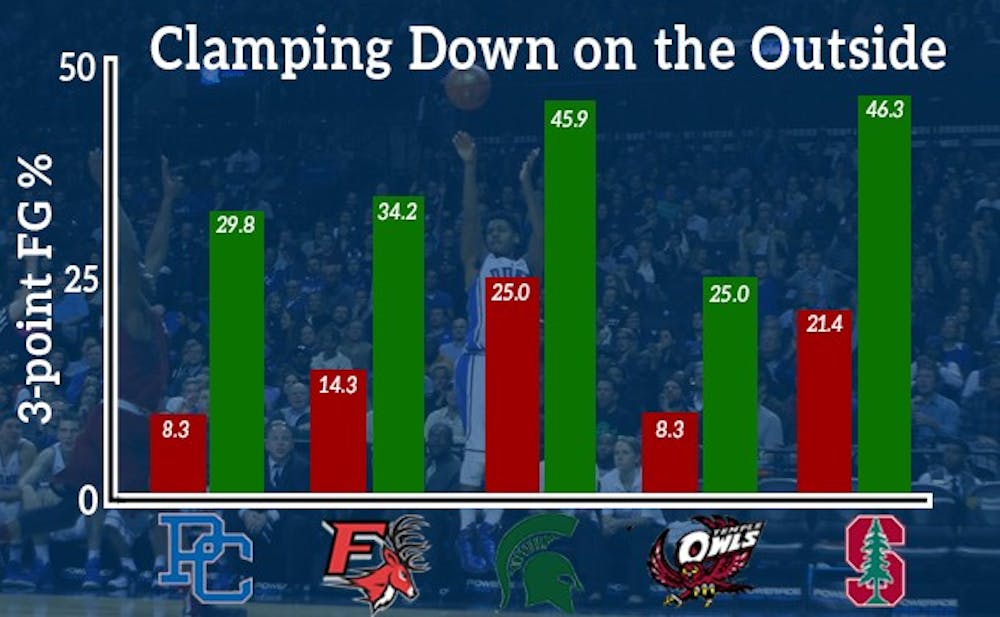In last year's first five games, Duke surrendered more than 60 points in five of six contests—including 94 points to Kansas in the Champions Classic and 90 points to Vermont in a one-point nail-biter that narrowly kept alive the nation's longest non-conference home winning streak.
What a difference a year makes.
Five games into this year's campaign, the Blue Devils have allowed 60 or more points just once, showcasing a motivated defense that has used the depth of the Duke bench to develop a stingy full-court press.
What's behind the resurgence of the Blue Devil defense? I think you can chalk it up to part-getting-back-to-the-program's-roots, part-having-a-stable-of-athletic-guards and part-Jahlil-Okafor-being-really-tall.

Before the season started, senior captain Quinn Cook said the presence of Okafor down low—a rim-protector that Duke sorely missed last season—would allow the Blue Devil guards to take some more chances on the perimeter, knowing that the freshman was playing behind them to help out should they get out of position. By jumping into passing lanes, getting up closer on the ball-handler and employing the full-court press, this year's Duke defense has made its living by not allowing opposing guards any comfort, particularly when it comes to launching from behind the 3-point line.
Due to the pressure applied by the Duke guards, opponents have struggled mightily shooting triples this season. Collectively, Presbyterian, Fairfield, Michigan State, Temple and Stanford have combined to shoot 12-for-72 from behind the arc against the Blue Devils. That's 16.7 percent, folks, and it's not going to win you a lot of basketball games, no matter who you play. When that somebody happens to be the No. 4 team in the country, one that shoots it at a 41.7 percent clip from distance at the other end, it's effectively game over.

It's not that the five teams Duke has played are necessarily bad 3-point shooters—Presbyterian being maybe the one exception. Against their other opponents so far this season, the Blue Devils' opponents are 88-for-250 from beyond the arc, or 35.2 percent. Two of those teams—Michigan State and Stanford—have veteran guards who have proven their shooting prowess in postseason play. The Spartans and Cardinal both shoot better than 40 percent when not playing Duke, but went a combined 8-for-34 last week against the tenacious Blue Devil perimeter defense.
Last year's shoddy early-season defense foreshadowed the season-long struggles that would ultimately curtail Duke's season far sooner than expected. I doubt the Blue Devils will be able to keep opponents to 16.7 percent shooting from distance all season long once ACC play kicks into gear, but there's good reason to expect that this year's Duke defense won't fold late in games as it did last year.

Bringing four McDonald's All-Americans off the bench—two of which are guards—is a great luxury for head coach Mike Krzyzewski, because it means fresh legs will never be an issue for his squad. With sizable guards in 6-foot-5 Rasheed Sulaimon, 6-foot-5 Matt Jones and 6-foot-6 Justise Winslow to contest 3-point shooters, and pesky point men in Quinn Cook and Tyus Jones to harass ball-handlers and make passes difficult—in the full-court, so far this year—the offense can't get in sync and can't get clean looks at the rim. When a Blue Devil gets blown by, Okafor and junior Amile Jefferson are there to control the paint.
I mentioned earlier that this inspired effort is due in part to a concerted attempt by Krzyzewski's staff to get back to the type of defense that defined the Duke program for years. We see those clips immortalized on Duke's all-time highlight reels—the Steve Wojciechowski floor slaps, the Shane Battier chase-down blocks.

But surprisingly enough, three of Krzyzewski's four national-title-winning teams gave up more than 70 points per game—that's more than last year's 67.4 per contest that had people up in arms about Duke's defensive lapses. Although the style and pace of the college game has definitely changed over the years, it's worth noting that a good Blue Devil defense doesn't promise any results when the calendar turns to March.
The Blue Devils are allowing 57.4 points per game through the first week and a half of the season, with Furman and Army coming to town this week. The Paladins and Black Knights shoot 26.3 and 31.8 percent from long range, respectively.
Expect those numbers to fall against one of the better Duke team defenses in the past few seasons.
Get The Chronicle straight to your inbox
Signup for our weekly newsletter. Cancel at any time.

